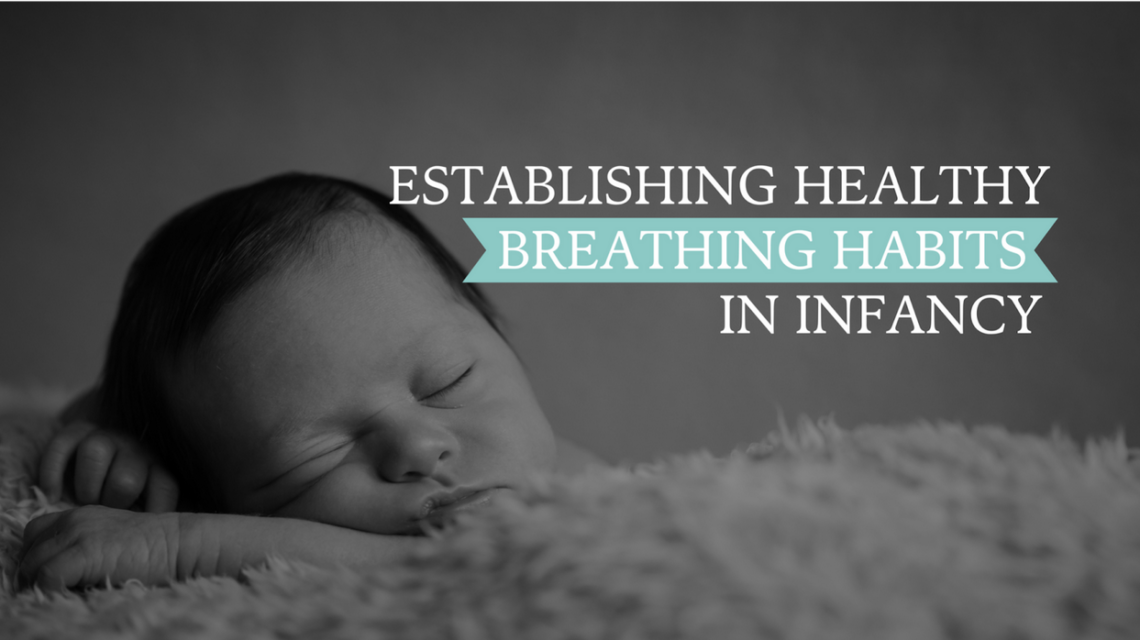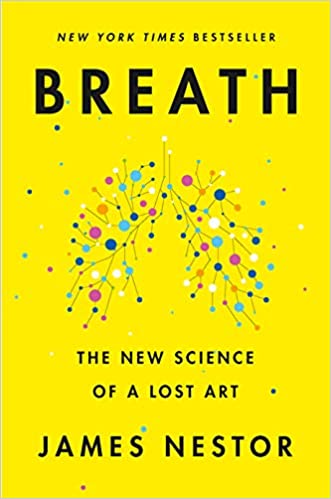6 Tips to Prevent Mouth Breathing in Infants and Children
What Is The Best Way for Babies to Breathe?
Every parent wants the best for their child’s health and well-being, and a fundamental aspect of that is proper breathing. The breath is one of the most under-rated aspects of our health that has a significant effect on several areas of one’s health and well-being, and the way one breathes makes all the difference.
We are designed to breathe through our nose, as the nose naturally filters out toxins and bacteria, humidifies the nasal passages, and enhances circulation. Occasional mouth breathing (due to a cold, for example) is not a cause for concern, but when it becomes chronic and habitual, it should not be overlooked. Over time, habitual mouth breathing impacts facial structure, increases stress, reduces tissue oxygenation, lowers cO2 levels, slows the metabolism and disrupts sleep. This is especially important to address in children who habitually mouth breathe during the day and while they sleep. Mouth breathing during sleep means the brain is not receiving adequate oxygen, triggering the sympathetic nervous system (fight or flight) and disrupting the healing and restoration processes that occur during sleep. If this continues, we start to see symptoms arise with emotional regulation, learning disabilities, hyperactivity, behavioral issues and other health concerns that affect a child’s growth and development.
Preventing Mouth Breathing During Sleep — Why This Is Important
👶 The key to preventing habitual mouth breathing in infants and children lies in understanding the interconnected elements of oral function, tongue posture and jaw development. In this blog, we discuss six essential tips to foster proper nasal breathing habits from infancy, setting the stage for a lifetime of healthy habits and well-being.
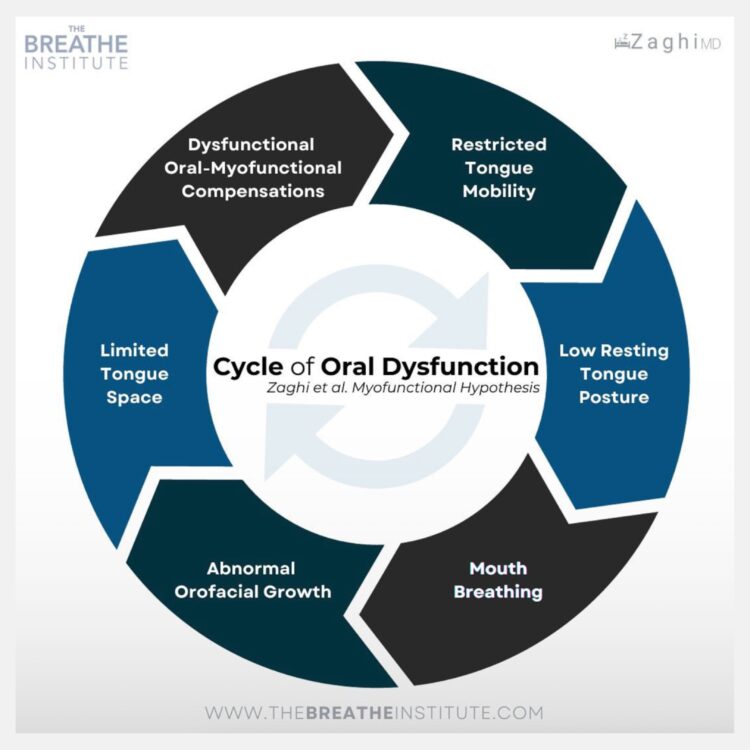

How To Mouth Prevent Mouth Breathing in Infants and Children
Below are 6 Tips to Prevent Mouth Breathing in Infants and Children.
Tip #1: Assess for any oral restrictions, such as a tongue-tie.
Oral restrictions such as a tongue tie can play a large role in mouth breathing, and can cascade into further complications down the road. Tongue-ties can hinder the tongue’s ability to rest on the top of the palate, which is essential for maintaining proper oral rest posture and establishing nasal breathing habits. If the tongue is restricted, it will naturally rest at the bottom of the mouth, causing low tongue posture, affecting the muscles of the mouth and oral cavity. This contributes to overall poor oral function and posture, leading to habitual mouth breathing.
It’s important to remember that the roof of the mouth is the floor of the nasal cavity. The tongue is meant to rest on the roof of the mouth, exerting continuous pressure to stimulate proper growth of the upper jaw – similar to how a retainer can influence teeth and structural alignment. The tongue plays a pivotal role in shaping the development of the airway and orofacial complex. With a tongue tie present, jaw development is impacted and can lead to a narrow palate, further perpetuating the vicious cycle of low tongue posture, poor oral function and habitual mouth breathing. To encourage nasal breathing and correct oral habits, assessing for oral ties should not be overlooked.
What Does A Tongue Tie Look Like? Below are some photos that illustrate what a tongue tie in babies looks like.


Tip #2: Encourage Lip Seal from Infancy
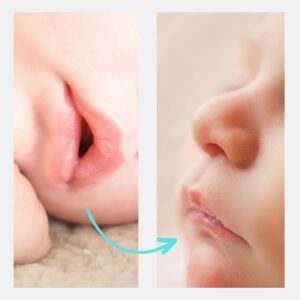

Encouraging a lip seal in children is pivotal for cultivating healthy nasal breathing habits, as the muscles of the oral cavity and mouth are intricately connected. Tongue posture and a lip seal go hand in hand when it comes to establishing these crucial habits.
With infants, if you notice them sleeping with their mouth open, gently push their chin up so the lips touch, and hold for a moment to allow the lips to seal. This simple practice encourages habitual nasal breathing during sleep and also acknowledges the broader impact of facial and oral muscle function, particularly the tongue, on activities like swallowing, chewing, speaking and even sleeping. Maintaining sealed lips and correct tongue posture encourages intraoral pressure dynamics to support a high tongue posture during rest, enhancing nasal breathing and minimizing potential airway obstructions. Alongside this, it’s important to ensure we keep our children’s nasal passages clear, bringing me to my next tip…
Tip #3: Keep Nasal Passages Clear
Maintaining unobstructed nasal passages is crucial in fostering proper nasal breathing and preventing mouth breathing in infants and children. If there’s any nasal obstruction, mouth breathing becomes automatic and habitual if not addressed. These are some effective methods to supporting a clear nose:


1. Consider using a nasal aspirator or nasal rinse, which can help eliminate congestion, reduce inflammation, and promote clear breathing.
Two popular trusted brands Dr. Johal recommends are NeilMed and Xlear. Both feature a kids sinus rinse safe for use by children and do not cause any burning sensation.
NeilMed SinuRinse Pediatric Starter Kit — this comes in an easy squeeze bottle system that allows you to deliver the saline solution with positive pressure to clean the nasal passages thoroughly, while maintaining your head in an upright position. You have complete control of the pressure and volume of solution, ensuring a gentle, soothing experience. Daily rinsing is safe and will keep your nasal passages clean, healthy and open. NO burning sensation.
Xlear Saline Kids Nasal spray — Kid’s Xlear Saline Nasal Spray with Xylitol was developed with children in mind. It’s a drug-free, kid-friendly nasal spray that contains xylitol—a natural ingredient that cleanses and moisturizes. Normal saline nasal sprays can dry out the nasal passage, actually leaving it more irritated and susceptible to external contaminants. But with the addition of xylitol, our natural kid’s nasal spray will moisturize and soothe your child’s nose and sinuses while alleviating congestion.
Check out Dr. Johal’s Nasal Hygiene Products (Canada)
Check out Dr. Johal’s Nasal Hygiene Products for Kids (United States)


2. A humidifier can keep the air moist, preventing dryness that can lead to nasal discomfort and congestion.
This quiet and easy to use humidifier works to humidify dry air in minutes. The Dual 150’s 3-liter (0.79-gallon) tank can run for up to 25 hours, helping you combat congestion, coughing, and dry skin. Unlike other humidifiers that leak and rattle, this is the cool mist humidifier you keep.
It’s a great way to sooth congestion and make sure the air is comfortable for your child.
Check out LEVOIT Humidifier (Canada)
Check out LEVOIT Humidifier (United States)
3. A valuable tool to have around the house is an air purifier, which will help reduce the presence of dust, pollen, and allergens in the air that can otherwise obstruct the nasal passages.
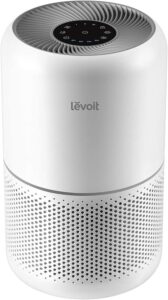

The Levoit Air Purifiers for Home Allergies and Pets work in bedrooms and large rooms. They feature an H13 True HEPA air filter that purifies 99.97% of smoke, dust, pollen, and odors. Whether your home has pets or if you simply live in an area where dust, pollen, and air quality are a general concern, air purifiers are a great investment for the home that can support cleaner air quality.
Check out Levoit Air Purifiers (Canada)
Check out Levoit Air Purifiers (United States)
We have gone above and beyond what’s required by protocol for our patients and staff. IQAir is a Swiss company specializing in technology solutions that help protect people from airborne pollutants. Dr. Johal has installed this air purifying system to eliminate airborne pathogens and filter the air in the office. It produces the highest medical grade filtration in the world. Additional suction has been integrated to grab airborne pathogens during all procedures.
At home, she invests in air quality through products such as the Levoit Air Purifier. These are great for your own home use or as a gift.
By taking these measures you can ensure that your child’s nasal passages are clear and open, minimizing mouth breathing as much as possible. Check out my Amazon storefront for my recommended nasal rinses, humidifiers and air purifiers!
Tip #4: Avoid Pacifiers and Bottles that Encourage Incorrect Oral Posture.
Choosing the right pacifiers and bottles for your child is pivotal in shaping oral development and habits from a young age, which plays a key role in preventing mouth breathing. The tongue’s influence on jaw and facial development and its role in mouth breathing cannot be overstated. Many pacifiers, bottles and sippy cups on the market are problematic as they create incorrect oral posture and swallow patterns, overuse/underuse certain facial muscles, and change the shape of the face – all which contribute to increased likeliness of mouth breathing.
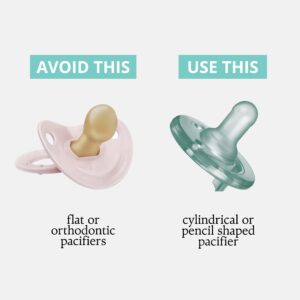

When it comes to pacifiers, it’s essential to be aware of their impact on jaw and facial development. While orthodontic pacifiers are marketed as a way to prevent future dental problems, they can, in fact, promote the use of incorrect tongue and facial muscles, leading to improper tongue posture and interfering with proper jaw and palatal development. Due to this, it is advisable to limit pacifier use and to start weaning your child off pacifiers around the age of 6 months, limiting their use to nighttime to ease the transition. Ideally, we want children to be weaned off their pacifier by the age of 1.
To minimize the negative effects that can come along with pacifiers, avoid flat top, bulbous shaped and orthodontic pacifiers. Instead, consider pacifiers that are cylindrical or pencil-shape, as they encourage elevation of the sides and back of the tongue, aiding in the development of the specific muscles necessary for proper oral posture, function and feeding skills. It’s important to note that any pacifier used long-term, regardless of its design, can have adverse effects on orofacial function and development. While the effects may not be immediately noticed in infancy and early childhood, as the child develops the repercussions become apparent.
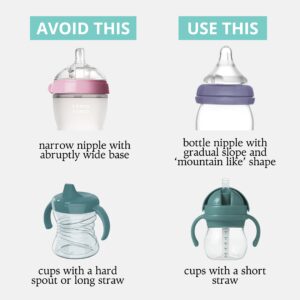

Since children develop oral habits beginning at a young age, it’s essential to provide bottles and sippy cups that support proper oral development. Opt for bottles with nipples featuring a gradual slope and ‘mountain-like’ shape with the slowest flow rate available. It’s important to steer clear of bottle nipples that resemble the ‘breast at rest’, as this is an inaccurate representation of what the nipple looks like during feeding. This shape encourages a shallow latch and can impede oral development and function. As your child is ready to move to sippy cups, avoid bottles with long, hard spouts or extended straws as they impede the tongue’s natural movement, encouraging the tongue to be pushed forward. This affects oral function and can lead to future complications related to airway, breathing, eating and speech. Instead, opt for bottles with a shorter straw that guide the tongue to touch just behind the front teeth during swallowing. If this straw is too long, trim it to the appropriate length so it does not rest on the tongue while drinking and swallowing. This practice helps to encourage proper tongue posture and swallow patterns as well as promotes the development of the essential lip and facial muscles crucial for nasal breathing.
Tip #5: Break Any Habits of Thumb/Finger Sucking


Breaking a thumb or finger sucking habit is essential to prevent habitual mouth breathing. While it may seem harmless, prolonged thumb sucking can lead to changes in the jaw and dentition, swallowing patterns, speech, tongue posture and can even impact the airway and breathing. Similar to prolonged pacifier use, this habit can result in changes in the oral structures and function that increase the potential of developing a mouth breathing habit and future complications down the road.
Thumb or finger sucking can affect the roof of the mouth (palate) or how the teeth line up. This can result in misaligned bite, problems in the development of a child’s teeth and jaw, etc. The more often and longer the duration that your child sucks on his or her thumb/finger, the higher the risk for developmental issues concerning their teeth and mouth structure.
To help your child overcome this habit, try some of these strategies:
👶 Explore a variety of teethers (Check out Dr. Johal’s recommendations on Baby Essentials – Pacifiers, Teethers, Bottles & Oral Care).
👶 Provide toys and books that keep fingers occupied and less likely to seek comfort in thumb/finger sucking.
👶 Be mindful of when thumb/finger sucking happens and investigate the underlying reasons. This way you can introduce alternative soothing methods to help your child transition away from this habit.
Tip #6: Encourage Chewing to Develop a Healthy, Wide Palate


To foster proper oral posture, nasal breathing and overall oral health, it’s essential to ensure your child’s jaw is developing nice and wide, providing enough space for the tongue to rest on the palate. As we have established in this blog, jaw development, tongue posture and nasal breathing are all interconnected with one another. One of the most effective ways we can encourage proper jaw growth and development is through chewing!
Consider incorporating teethers and chew toys from a young age. As your child grows, introduce foods that promote chewing and engage the jaw muscles. Minimize or avoid soft, processed foods that limit muscle activity, as they impede the development of the jaw. By prioritizing chewing exercises and a balanced diet, you can aid in the formation of wide, healthy jaws that support optimal oral posture and nasal breathing for your child.
Conclusion
In the pursuit of promoting proper nasal breathing in infants and children, it becomes evident that the process involves various interconnected components. As we’ve explored these 6 vital tips, it’s clear that proper nasal breathing encompasses a combination of structural and functional oral development and muscle function. If you find your child developing a mouth breathing habit, there’s no need to feel discouraged as we can intervene at any stage of growth (even as adults!). Proper breathing is a journey with many moving parts, but with dedication and the right guidance, we can help our children establish healthy nasal breathing habits, supporting their oral and whole body health and well-being.
For more, make sure to check out my Amazon shop for all the products I recommend in this blog!
Recommended Reading
If you are interested in learning more about the science of breath and how it affects your optimal health, see below.
Breath: The New Science of a Lost Art by James Nestor is A New York Times Bestseller, A Washington Post Notable Nonfiction Book of 2020, and named a Best Book of 2020 by NPR.
This is an excellent book that Dr. Johal recommends to patients and colleagues alike on a regular basis. The author, James Nestor, travels the world while researching for the book to try different techniques on himself. He has a gift of sharing what he learns with us in an easy to read and engaging way.
The key takeaway from this book is that there are many qualities to breathing that are vital to our health.
For example, he discusses many modern health issues such as asthma, anxiety, ADHD, which can be reduced or even reversed simply by changing the way we inhale and exhale. Nestor explains the evolutionary changes in our facial structure over the past several hundred years and how they contribute to our breathing and health problems. He talks about the adverse affects of mouth breathing (which 80% of us do) and how, in an experiment, his health rebounded when he trained himself to only breath through his nose.
In this book you will also find a lot of breathing exercises that you can implement right away. He explains how to do them and why they are effective. If you’re stressed, if you snore, if you have sleep apnea, if you have other respiratory issues, or if you know someone who suffers from these ailments, then this book might may be helpful in offering new insights to your health situation. It’s both informative, easy and fun to read. Simply put, it offers easy ways for you to feel better and healthier through your breath.
Family Dental Centre Home Page: www.familydentalguelph.com


